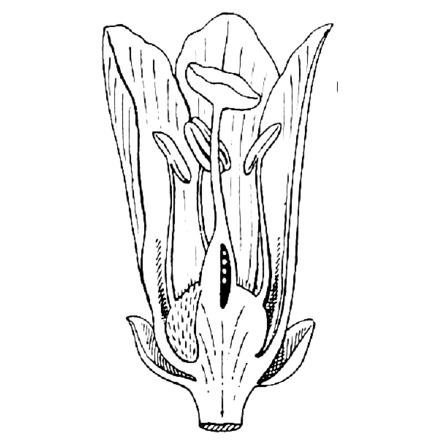Medium-to large-sized tree to 40 m tall and >3 m girth; bole to 25 m, with or without buttresses (to 2 m); crown fairly wide, spreading, occasionally dense. Bark whitish, grey-brown, grey or light-brown, usually vertically fissured and flaking; inner bark pinkish-white,-brown, reddish-brown or-orange, fibrous; sapwood white, pink or pale red; sweetly aromatic when cut. Twigs often prominently lenticellate with verru-cose lenticels. Leaves 29–84 cm long, usually 6–9(–12)-jugate; rachides glabrescent to moderately pilose, occasionally velutinous; petioles 7–12 cm long, glabrescent to pilose, often lenticellate. Leaflets lanceolate to ovate-lanceolate, margins entire, 7–14(–19.5) by 3–6(–7) cm, glabrescent to moderately pilose, usually with short hairs and club-glands on the upper midribs, lower vascular system pilose, apices acuminate, occasionally acute, bases symmetrical to asymmetrical; petiolules (0.2–)0.4–1.2 cm long, glabrescent to pilose/villous. Inflorescences up to 40 cm long, pendent, sweetly aromatic; rachides pilose to villous with medium to long spreading hairs, occasionally glabrescent; pedicels (0.3–)0.75–1.25 mm long, pilose to villous. Flowers 4–5 mm long. Calyx 1–1.5 mm long, glabrescent to pilose externally, lobes imbricate; sepals usually triangular, espe-cially in bud, 0.6–1 by 0.8–1.5 mm, glabrescent to villous externally, apices usually acute, margins ciliate. Petals white, creamy-white or pinkish, 3.5–5 by 1.6–3.2 mm, glabrescent to villous, but usually with conspicuous central bands of long appressed hairs in bud, margins ciliate with long hairs. Androgynophore 2.5–4.7 mm long. Fila-ments 1.25–2.5 mm long (male flowers), 1–1.3 mm long (female flowers), pilose to villous with scattered to dense long hairs. Anthers 0.75–1.25 mm long, 0.3–0.8 mm broad, apices usually apiculate. Antherodes 0.5–0.9 mm long, 0.25–0.6 mm broad, sagittate. Disk 1.25–2.5 mm diam., orange to red, densely pilose. Ovary 1.6–2.75 mm diam., moderately to densely pilose; locules to 6-ovulate. Style 1.25–3 mm long, 0.25– 0.5 mm broad (male), 0.5–1 mm long, c. 0.3 mm broad (female), pilose with scattered usually appressed hairs especially on the lower half; stylehead 0.75–1.25 mm diam. Capsule 14–20(–24) mm long; columella 14–20(–24) mm long, 5–8(–10) mm broad, concave with apical scarring; valves dark-to blackish-brown, rough, verrucose with conspicuous, often ovate rusty lenticels, 0.3–2 by 0.4–1.25 mm. Seeds winged at both ends, 11–20(–22) by (3–)4–4.8 mm, wings unequal with broadly obtuse apices; seed body 5–8 by 1.5–2 mm.
A tree. It grows 40 m tall. The trunk can be 1-3 m across. The crown is wide spreading. The leaves have leaflets along the stalk. The leaves are 29-84 cm long. They are clustered in spirals near the ends of twigs. The flowering shoots are near the tips of branches. The fruit are leathery capsules 25 mm long.


